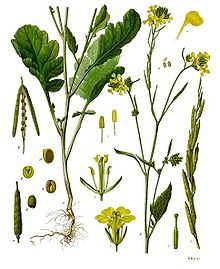- Brassica nigra
-
Brassica nigra 
Scientific classification Kingdom: Plantae (unranked): Angiosperms (unranked): Eudicots (unranked): Rosids Order: Brassicales Family: Brassicaceae Genus: Brassica Species: B. nigra Binomial name Brassica nigra
L.Brassica nigra (black mustard) ( sanskrit : राजक्षवक , rajakshavak ; Marathi :काळी मोहरी , Kali Mohari ) is an annual weedy plant cultivated for its seeds, which are commonly used as a spice.
Contents
Description
The plant is believed to be native to the southern Mediterranean region of Europe, and has been cultivated for thousands of years.
The spice is generally made from ground seeds of the plant, with the seed coats removed. The small (1 mm) seeds are hard and vary in color from dark brown to black. They are flavorful, although they have almost no aroma. The seeds are commonly used in Indian cuisine, for example in curry, where it is known as rai. The seeds are usually thrown into hot oil or ghee, after which they pop, releasing a characteristic nutty flavor. The seeds have a significant amount of fatty oil. This oil is used often as cooking oil in India.
In Ethiopia, where it is cultivated as a vegetable in Gondar, Harar and Shewa, the shoots and leaves are consumed cooked and the seeds used as a spice. Its Amharic name is senafitch.[1]
Ground seeds of the plant mixed with honey are widely used in eastern Europe as cough suppressant. In Eastern Canada, the use of mouche de moutarde to treat respiratory infections was popular before the advent of modern medicine. It consisted in mixing ground mustard seeds with flour and water, and creating a cataplasm with the paste. This cataplasm was put on the chest or the back and left until the person felt a stinging sensation.
The plant itself can grow from two to eight feet tall, with racemes of small yellow flowers. These flowers are usually up to 1/3" across, with four petals each. The leaves are covered in small hairs; they can wilt on hot days, but recover at night.
Since the 1950s, black mustard has become less popular as compared to India mustard because some cultivars of India mustard have seeds that can be mechanically harvested in a more efficient manner.
Black mustard is thought to be the seed mentioned by Jesus in Matthew 13:31-32.[2]
Similar plants
Despite their similar common names, black mustard and white mustard (genus Sinapis) are not closely related. Black mustard belongs to the same genus as cabbage.
B. nigra also resembles Hirschfeldia incana, or hoary mustard, (formerly Brassica geniculata), which is a perennial plant.
See also
References
- ^ Zemede Asfaw, "Conservation and use of traditional vegetables in Ethiopia", Proceedings of the IPGRI International Workshop on Genetic Resources of Traditional Vegetables in Africa (Nairobi, 29–31 August 1995)
- ^ Post, George Edward (1900). "Mustard". In James Hastings. A Dictionary of the Bible. http://www.odu.edu/~lmusselm/post/dictionary/hastings_dic/pages/mustard.shtml.
External links
- Entry in Gernot Katzer's spice pages, with pictures and detailed information
- Entry in Illinois Wildflowers
Brassica Brassica carinata • Brassica juncea • Brassica napus • Brassica nigra • Brassica rapa • Brassica tournefortii • Canola • Celery cabbage • Chinese cabbage • Coleslaw • Collard greens • Kapusta • Kohlrabi • Meigan cai • Mustard plant • Napa cabbage • Pao cai • Rapeseed • Rapini • Rutabaga • Sauerkraut • Spring greens • Suan cai • Tatsoi • Tianjin preserved vegetable • Triangle of U • Turnip • Zha caiCategories:- Brassica
- Flora of North Dakota
- Medicinal plants
Wikimedia Foundation. 2010.
